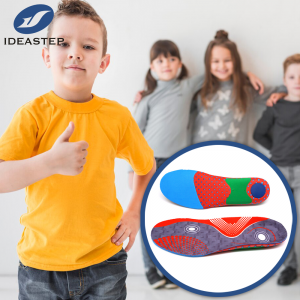
In the previous blog”Why Do Children Need Shoe Insoles Too?“, we discussed that the choice of whether to use insoles in children’s running shoes can significantly impact their comfort, support, and overall foot health during physical activities. This article aims to provide a comprehensive exploration of the differences between using and not using insoles in children’s running shoes, shedding light on the potential benefits, considerations, and implications for young runners.
1. Impact Absorption and Cushioning
Using Insoles: Insoles in children’s running shoes can enhance impact absorption and cushioning, particularly during high-impact activities such as running. The presence of cushioned insoles helps to reduce the stress on the feet and lower limbs, providing a more comfortable and supportive experience for young runners.
Not Using Insoles: Without insoles, children may experience a lack of adequate impact absorption and cushioning, potentially leading to discomfort, fatigue, and an increased risk of overuse injuries. The absence of cushioning can also result in greater impact forces on the feet, potentially affecting their natural biomechanics and overall running performance.
2. Arch Support and Foot Alignment
Using Insoles: Insoles with built-in arch support can promote proper foot alignment and provide additional support for the arches of children’s feet. This is particularly beneficial for young runners with flat feet or overpronation, as well as those who require extra stability during running activities.
Not Using Insoles: Without the support of insoles, children with specific foot conditions or biomechanical issues may experience inadequate arch support, potentially leading to discomfort, fatigue, and an increased risk of developing foot-related problems over time. The absence of arch support can also impact the overall stability and efficiency of their running gait.
3. Comfort and Customization
Using Insoles: Insoles allow for a level of customization and comfort adjustment within children’s running shoes. They can cater to individual foot shapes and provide a more personalized fit, addressing specific comfort preferences and potential areas of discomfort.
Not Using Insoles: The absence of insoles may limit the customization and comfort options within children’s running shoes, potentially leading to a less tailored fit and reduced comfort during running activities. This can impact the overall enjoyment and willingness of children to engage in physical activities.
In conclusion, the decision to use or not use insoles in children’s running shoes can significantly influence their running experience and foot health. By providing impact absorption, cushioning, arch support, and customization options, insoles contribute to a more comfortable, supportive, and personalized running experience for young runners. If you are interested in Kids insoles, you can continue to visit this page (https://www.aideastep.com/kids-insoles/) and tell us your needs.
